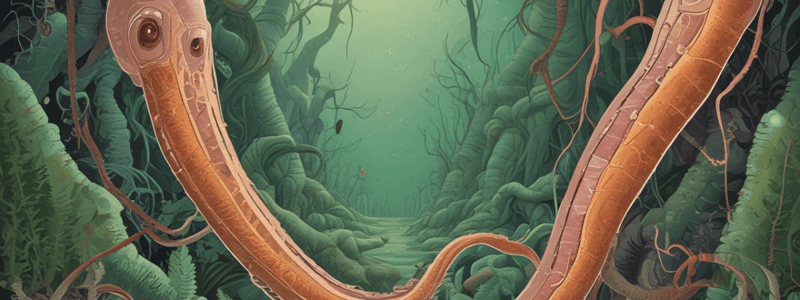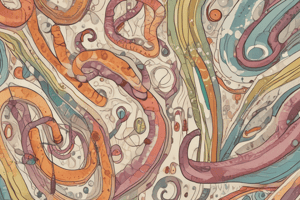Podcast
Questions and Answers
What is the characteristic feature of the body of trematodes?
What is the characteristic feature of the body of trematodes?
- Presence of a tail
- Segmented body
- Presence of anus
- Presence of two suckers (correct)
Which type of fluke is responsible for water-borne parasitic disease?
Which type of fluke is responsible for water-borne parasitic disease?
- Lung fluke
- Hepatic fluke
- Blood fluke (correct)
- Intestinal fluke
Where do adult worms of S.mansoni inhabit in the human body?
Where do adult worms of S.mansoni inhabit in the human body?
- Mesenteric veins of sigmoido-rectal region (correct)
- Mesenteric veins of ileo-cecal region
- Hepatic veins
- Veins of vesical and pelvic plexuses
What is the intermediate host of the schistosome life cycle?
What is the intermediate host of the schistosome life cycle?
What is the process by which the conjoined couple of worms ascend the mesenteric vessels?
What is the process by which the conjoined couple of worms ascend the mesenteric vessels?
What is the type of reproduction that occurs within the intermediate host?
What is the type of reproduction that occurs within the intermediate host?
What is the primary site where the eggs of S.haematobium are discharged?
What is the primary site where the eggs of S.haematobium are discharged?
What is the intermediate host for S.mansoni?
What is the intermediate host for S.mansoni?
What is the primary site where the eggs of S.mansoni and S.japonicum are swept back into the circulation and lodge in?
What is the primary site where the eggs of S.mansoni and S.japonicum are swept back into the circulation and lodge in?
What is the final host for S.japonicum?
What is the final host for S.japonicum?
What is the stage of the parasite that penetrates human skin?
What is the stage of the parasite that penetrates human skin?
What is the most significant pathology associated with in schistosomiasis?
What is the most significant pathology associated with in schistosomiasis?
What is the result of a granulomatous reaction surrounding the eggs in the liver with S.mansoni and S.japonicum?
What is the result of a granulomatous reaction surrounding the eggs in the liver with S.mansoni and S.japonicum?
What is the characteristic of S.haematobium infections?
What is the characteristic of S.haematobium infections?
What is the term for the symptoms that occur after cercarial penetration in travelers to endemic countries?
What is the term for the symptoms that occur after cercarial penetration in travelers to endemic countries?
What is the primary cause of morbidity and mortality in chronic schistosomiasis?
What is the primary cause of morbidity and mortality in chronic schistosomiasis?
What is the duration of localized pruritus after cercarial penetration?
What is the duration of localized pruritus after cercarial penetration?
What is the incubation period for the development of Katayama syndrome in non-immune individuals?
What is the incubation period for the development of Katayama syndrome in non-immune individuals?
What is a common symptom associated with the onset of fever in this syndrome?
What is a common symptom associated with the onset of fever in this syndrome?
What is the result of gradual accumulation of scar tissue within the bladder and ureters?
What is the result of gradual accumulation of scar tissue within the bladder and ureters?
What type of inflammation is formed by host lymphocytes, eosinophils, and macrophages in response to trapped parasite eggs?
What type of inflammation is formed by host lymphocytes, eosinophils, and macrophages in response to trapped parasite eggs?
What is the result of eggs passing into the brain, spinal cord, and meninges?
What is the result of eggs passing into the brain, spinal cord, and meninges?
What is the outcome of the inflammation associated with scar formation in the bladder and ureters?
What is the outcome of the inflammation associated with scar formation in the bladder and ureters?
What is the result of chronic systemic inflammatory illness in this syndrome?
What is the result of chronic systemic inflammatory illness in this syndrome?
What is the primary goal of controlling schistosomiasis infection?
What is the primary goal of controlling schistosomiasis infection?
What is the mechanism of action of Praziquantel against Schistosoma species?
What is the mechanism of action of Praziquantel against Schistosoma species?
What is the typical diagnostic method for schistosomiasis?
What is the typical diagnostic method for schistosomiasis?
What is the recommended treatment for Katayama syndrome?
What is the recommended treatment for Katayama syndrome?
What is the consequence of schistosomiasis infection if left untreated?
What is the consequence of schistosomiasis infection if left untreated?
What is the effective way to prevent schistosomiasis infection?
What is the effective way to prevent schistosomiasis infection?
What is the possible outcome of inflammation caused by Schistosoma infection?
What is the possible outcome of inflammation caused by Schistosoma infection?
What is the primary mechanism of action of Praziquantel against Schistosoma species?
What is the primary mechanism of action of Praziquantel against Schistosoma species?
What is the most effective way to control Schistosoma infection?
What is the most effective way to control Schistosoma infection?
What is the primary purpose of biopsies in diagnosing Schistosoma infection?
What is the primary purpose of biopsies in diagnosing Schistosoma infection?
What is the role of antihistamines and corticosteroids in treating Katayama syndrome?
What is the role of antihistamines and corticosteroids in treating Katayama syndrome?
What is the result of the granulomatous reaction surrounding the eggs in the liver?
What is the result of the granulomatous reaction surrounding the eggs in the liver?
What is the primary method of diagnosing Schistosoma infection?
What is the primary method of diagnosing Schistosoma infection?
What is the consequence of chronic Schistosoma infection?
What is the consequence of chronic Schistosoma infection?
What is the primary goal of controlling Schistosoma infection?
What is the primary goal of controlling Schistosoma infection?
What is the effect of Praziquantel on the Schistosoma worms?
What is the effect of Praziquantel on the Schistosoma worms?
Flashcards
What are trematodes?
What are trematodes?
Leaf-like, unsegmented flatworms with two suckers (oral and ventral). They have a mouth surrounded by oral suckers, a pharynx, and an esophagus; they lack an anus.
What are the types of trematodes?
What are the types of trematodes?
Trematodes are classified by their location in the host. Common types include blood flukes, intestinal flukes, hepatic (liver) flukes, and lung flukes.
What is Schistosomiasis?
What is Schistosomiasis?
A parasitic disease caused by blood flukes (Schistosoma japonicum, S. mansoni, and S. haematobium). It is spread through contact with contaminated water.
What is the life cycle of a Schistosoma fluke?
What is the life cycle of a Schistosoma fluke?
Signup and view all the flashcards
What is the main pathology associated with Schistosomiasis?
What is the main pathology associated with Schistosomiasis?
Signup and view all the flashcards
What are the long-term effects of Schistosoma infections?
What are the long-term effects of Schistosoma infections?
Signup and view all the flashcards
What are the symptoms of acute Schistosomiasis?
What are the symptoms of acute Schistosomiasis?
Signup and view all the flashcards
What are the symptoms of chronic Schistosomiasis?
What are the symptoms of chronic Schistosomiasis?
Signup and view all the flashcards
How is Schistosomiasis diagnosed?
How is Schistosomiasis diagnosed?
Signup and view all the flashcards
What is the treatment for Schistosomiasis?
What is the treatment for Schistosomiasis?
Signup and view all the flashcards
What is Katayama syndrome?
What is Katayama syndrome?
Signup and view all the flashcards
Is there a cure for Katayama syndrome?
Is there a cure for Katayama syndrome?
Signup and view all the flashcards
How can Schistosomiasis be prevented?
How can Schistosomiasis be prevented?
Signup and view all the flashcards
How do schistosome eggs cause pathology?
How do schistosome eggs cause pathology?
Signup and view all the flashcards
What is the consequence of egg-induced inflammation?
What is the consequence of egg-induced inflammation?
Signup and view all the flashcards
How does Schistosomiasis affect the liver?
How does Schistosomiasis affect the liver?
Signup and view all the flashcards
How does Schistosomiasis affect the bladder?
How does Schistosomiasis affect the bladder?
Signup and view all the flashcards
What is hydronephrosis?
What is hydronephrosis?
Signup and view all the flashcards
How can Schistosomiasis be prevented?
How can Schistosomiasis be prevented?
Signup and view all the flashcards
What is a definitive host?
What is a definitive host?
Signup and view all the flashcards
What is an intermediate host?
What is an intermediate host?
Signup and view all the flashcards
What is a miracidium?
What is a miracidium?
Signup and view all the flashcards
What is a cercaria?
What is a cercaria?
Signup and view all the flashcards
What is a schistosomule?
What is a schistosomule?
Signup and view all the flashcards
What is the significance of Schistosoma japonicum infection?
What is the significance of Schistosoma japonicum infection?
Signup and view all the flashcards
How does Schistosoma haematobium affect the bladder?
How does Schistosoma haematobium affect the bladder?
Signup and view all the flashcards
Study Notes
Trematodes (Flukes)
- Leaf-like, unsegmented flat worms with two suckers (oral and ventral)
- Body consists of a mouth surrounded by oral suckers, a pharynx, and an esophagus; anus is absent
Classification
- Blood fluke
- Intestinal fluke
- Hepatic fluke
- Lung fluke
- Blood flukes: Schistosoma japonicum, Schistosoma mansoni, and Schistosoma haematobium cause water-borne parasitic disease (Schistosomiasis or Bilharziasis)
Life Cycle
- Adult dioecious (male and female) sexual stage within the definitive host (human)
- Asexual reproductive stage within an intermediate host (snail)
- Female schistosomes lay hundreds or thousands of eggs per day within the venous system
- Eggs are discharged in urine (S. haematobium) or feces (S. mansoni and S. japonicum)
- In water, eggs hatch, releasing miracidia (first larval stage)
- Miracidia are eaten by certain snails (intermediate hosts)
- Miracidia develop to a second larval stage (sporocyst stage) and then the infectious stage cercariae
- Cercariae leave the snail and swim to penetrate human skin
- Cercariae transform into schistosomules, which enter the peripheral circulation and eventually become adults in the hepatoportal system or venous plexus surrounding the bladder
Pathology and Pathogenesis
- Most significant pathology is associated with schistosome eggs, not adult worms
- Eggs cause granulomatous reaction, leading to fibrosis in the liver with S. mansoni and S. japonicum
- Chronic cases lead to portal hypertension, accumulation of ascites in the abdominal cavity, hepatosplenomegaly, and esophageal varices
- S. haematobium infections involve urinary tract: urethral pain, increased urinary frequency, dysuria, hematuria, and bladder obstruction leading to secondary bacterial infections
Signs and Symptoms
- Acute manifestations: localized pruritus, urticarial rash, fever, headache, chills, diarrhea, and eosinophilia (snail fever or Katayama fever)
- Chronic systemic inflammatory illness: weight loss, hepatosplenomegaly, diarrhea, constipation, and dysentery-like illness with bloody bowel movements
- Bilharzia: S. haematobium eggs trapped in host tissues, leading to delayed-type hypersensitivity granulomatous inflammation, scar formation, and obstruction, resulting in hydronephrosis, bladder calcification, and squamous cell carcinoma of the bladder
Diagnosis
- Detection of ova in fecal or urine smear preparations
- Invasive procedures—biopsy material are effective in visualizing eggs when the stool or urine sample testing is negative
- Serology: S. mansoni, S. haematobium, S. japonicum
Treatment
- Praziquantel is active against all Schistosoma species
- Praziquantel’s mechanism of action: damages the worm’s outer tegument membrane, exposing the worm to the body’s immune response, leading to worm death
- No specific therapy is available for the treatment of Katayama syndrome
- Antihistamines and corticosteroids may be helpful
Control of Infection
- Eradication of the intermediate snail hosts
- Prevention of water pollution with human excreta
- Avoidance of swimming in contaminated water
- Effective treatment of infected persons
Studying That Suits You
Use AI to generate personalized quizzes and flashcards to suit your learning preferences.




